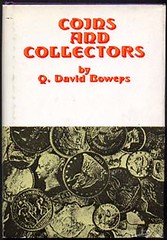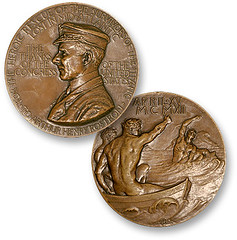
About UsThe Numismatic Bibliomania Society is a non-profit organization promoting numismatic literature. For more information please see our web site at coinbooks.org SubscriptionsThose wishing to become new E-Sylum subscribers (or wishing to Unsubscribe) can go to the following web page link MembershipThere is a membership application available on the web site Membership Application To join, print the application and return it with your check to the address printed on the application. Membership is only $15 to addresses in the U.S., $20 for First Class mail, and $25 elsewhere. For those without web access, write to: David M. Sundman, Secretary/TreasurerNumismatic Bibliomania
Society AsylumFor Asylum mailing address changes and other membership questions, contact David at this email address: dsundman@LittletonCoin.com SubmissionsTo submit items for publication in The E-Sylum, just Reply to this message, or write to the Editor at this address: whomren@coinlibrary.com
BUY THE BOOK BEFORE THE COINYou won't regret it! |
- WAYNE'S WORDS: THE E-SYLUM JULY 24, 2011
- NUMISMATIC BIBLIOMANIA SOCIETY AWARDS AND OFFICERS
- NEW BOOK: ISLAMIC COINS STRUCK IN HISTORIC ARMENIA VOL I
- HELP SOUGHT FOR UPCOMING BOOK ON REPLACEMENT NOTES
- COINS AND COLLECTORS BY Q. DAVID BOWERS
- MORE ON CHARLES MCSORLEY
- THE EARL OF PEMBROKE COLLECTION
- SWITT'S 1933 DOUBLE EAGLES TO REMAIN IN GOVERNMENT HANDS
- ALISON FRANKEL: HOW THE GOVERNMENT WON THE SWITT 1933 DOUBLE EAGLE CASE
- MORE ON THE AMERICAN ACCOMPTANT AND THE FIRST PRINTED DOLLAR SIGN
- BIBLIOMANIA, NBS, AND THE E-SYLUM
- MORE ON THE HALLMARKS OF THEOPHILUS BRADBURY
- HERITAGE TO AUCTION 1792 FUSIBLE ALLOY CENT
- MORE ON DOLLAR COINS VS PAPER DOLLARS
- NOTES FROM E-SYLUM READERS: JULY 24, 2011
- MAN CHARGED IN THEFT OF RARE ALASKAN NATIONAL BANK NOTES
- MORE ON INGLE SYSTEM SCRIP
- CARPATHIA CAPTAIN'S CONGRESSIONAL GOLD MEDAL FOUND
- PROVIDENCE'S PARKING METER COIN CACHE
- ROYAL NATIONAL LIFEBOAT INSTITUTION MEDALS
- ROMAN ERA COIN DIE AND BLANKS UNEARTHED
- FEATURED WEB SITE: DUKE UNIVERSITY CURRENCY COLLECTION
WAYNE'S WORDS: THE E-SYLUM JULY 24, 2011

Among our new subscribers this week are Terry Carver, Tony Chibbaro, and Ken Conaway. Welcome aboard!
We have 1,440 email subscribers, plus 153 followers on Facebook, including Say Peng.
There was one notable omission in last week's issue - in the two items relating to Karl Moulton I neglected to include contact information. Sorry! Karl may be reached via numiscats@aol.com or www.coincats.com .
OK, another correction: Pete Smith and Donn Perlman noted that last week's headline about the Numismatic Theatre programs at the upcoming ANA convention indicated "2001" rather than 2011. Oops! The error only occurred in the email version. Our webmaster Bruce Perdue caught the error and fixed it before posting the issue online.
This week we open with an NBS web site update and a plea for assistance from Joel Orosz. Next we have an announcement of a new book on Islamic coins and a request for help on a book about replacement notes. Other topics include the 1933 Double Eagle legal case and the Earl of Pembroke collection.
To learn more about the 1792 Fusible Alloy cent and the whereabouts of Captain Rostron's Congressional Gold medal, read on. Have a great week, everyone!
Wayne Homren
Numismatic Bibliomania Society
NUMISMATIC BIBLIOMANIA SOCIETY AWARDS AND OFFICERS
NBS Board member Joel Orosz writes:
NBS President Dan Hamelberg recently asked me, as the NBS Historian/Archivist, to compile comprehensive lists of all awards presented by the club, and all elected officers, board members, and appointed positions of the club since its founding in 1979. The Asylum, The E-Sylum, and the NBS Archives provided all of the answers for the elected officers, board members and appointed positions, and most of the answers for the awards, as well.
There are, however, some missing names in the awards for the Best Article published in The Asylum. Please look over the "missing years," and if you won the Best Article award for that year, or know who did, please contact me at: Joeljorosz@gmail.com so that we can complete our records. Thanks very much in advance for your help!
To review the web pages, see:
NUMISMATIC BIBLIOMANIA SOCIETY AWARDS, 1979-2010
(www.coinbooks.org/about/awards.html )
Officers (2010-2012)
(www.coinbooks.org/about/officers.html)
Past Officers and Governors
(www.coinbooks.org/about/officers_past.html)
NEW BOOK: ISLAMIC COINS STRUCK IN HISTORIC ARMENIA VOL I
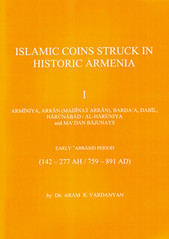 ISLAMIC COINS STRUCK IN HISTORIC ARMENIA, vol. I. Armīniya, Arrān (Madīnat Arrān), Bardaa, Dabīl, Hārūnābād/al-Hārūniya and Maden Bājunays. Early Abbāsid Period (142 277 AH / 759 891 AD).
ISLAMIC COINS STRUCK IN HISTORIC ARMENIA, vol. I. Armīniya, Arrān (Madīnat Arrān), Bardaa, Dabīl, Hārūnābād/al-Hārūniya and Maden Bājunays. Early Abbāsid Period (142 277 AH / 759 891 AD).
This is the first publication in the intended series dealing with cataloguing of Islamic coins struck in Armenia in the Medieval epoch. This volume represents an up to date catalogue of gold, silver and copper coins struck at the mints of Armīniya, Arrān (also Madīnat Arrān), Bardaa, Dabīl, Maden Bājunays, Hārūnābād and al-Hārūniya, all located in the historic Armenia. Chronologically it covers the so-called Early Abbāsid and the Samarrā periods (132 277 AH). The catalogue includes ca. 260 coin types, all provided with illustrations given for each type.
Contents:
1. Introduction
2. Catalogue
3. Gold coins
4. Silver coins
5. Copper coins
6. Chronology of Abbādis governors of Armenia (132 220 AH)
7. Tables
8. Index of personal names and signs (symbols)
Published. ISBN 978-99941-0-418-5, 148 pages, A4 format, soft cover, glossy paper. "Tigran Mets" Publ. House, Yerevan, 2011. Price: 40 euros + shipping 5 euros.
The total price incl. shipping is 45 euros. 10 % of discount is offered if buying more than 3 copies. To purchase this catalogue please contact the author at: aramvardanian@yahoo.com
HELP SOUGHT FOR UPCOMING BOOK ON REPLACEMENT NOTES
Dr. Ali Mehilba writes:
The Arabic Chapter of International Banknote Society (IBNS) has published a few books about the history of banknotes including a book about Egypt , another about Kuwait and our last book about Libya. Our next book will cover world Replacements.
A replacement banknote is a banknote that is printed to replace a faulty one and is used as a control mechanism for governments or monetary authorities to know the exact number of banknotes being printed. As quality control finds defective notes in the printing process after the serial number has been overprinted, they are taken out with their serial number written down and replaced with another banknote printed specifically for this purpose, so that the amount of banknote being printed stays the same in each production batch. This saves time and money compared to re-printing exactly the same serial number that was used before. It is rare that the replacement banknote has the same serial number as the original faulty one. A replacement note will have its own serial numbering system that separates it from the normal numbering system.
I would appreciate it if your readers can support su with information about replacement notes of countries that you have data for. We are willing to cover any cost and also will mention in our book in the acknowledgments. I mainly need detailed information on the replacement notes in each country: When did they start ? How does it work ? I could use a scan or better original notes which we will pay for.
Dr. Ali Mehilba
President of Arabic Chapter of International Banknote Society IBNS
247 Horia Street ;Sporting ;Alexandria
EGYPT
Tel +2012 213 7814
AliMehilba@yahoo.com
COINS AND COLLECTORS BY Q. DAVID BOWERS
"Coins and Collectors" has always been one of my favorite numismatic books, a nice history of the hobby of coin collecting (as opposed to a history of coins themselves).
Has Dave ever considered updating it, or putting out a Volume 2? I'm sure he already has about seventy million other book ideas on his plate, but it's been almost 50 years (wow!) since "Coins and Collectors" came out, and I'd like to see his take on the history of the hobby in the intervening years.
Dave Bowers writes:
Thanks to you and John and Nancy Wilson for the neat review of my book. - It was interesting to read your comments about COINS AND COLLECTORS, my first book, in 1964. This sold perhaps 5,000 copies at the time, then was picked up by Bonanza or Crown, I'd have to check, distributed everywhere, and over 100,000 copies were sold!
I probably should sweet talk Dennis Tucker (at Whitman Publishing) into having me update and reissue. I have received so many letters about this book in the over 40 years since 1964, usually saying that "this book started me collecting."
To read the earlier E-Sylum article, see: BOOK REVIEW: COLLECTING RARE COINS FOR PLEASURE AND PROFIT (www.coinbooks.org/esylum_v14n29a07.html)
"FIFTY YEARS IN THE MAKING: A GUIDE BOOK OF MEXICAN NUMISMATICS."
MORE ON CHARLES MCSORLEY
Regarding the late medal dealer Charles McSorley, Alan V. Weinberg writes:
I was saddened in reading of Charley McSorley's death but of course it was inevitable as he was in his 80's and still "doing political shows" at some distance to his NJ home. I've known Charley since the early 1960's when he and I lived in New Jersey. He handled in all those years some of the finest American rarities known including a superb immaculate proof silver Thomas Jefferson inaugural medal that went into the famous Joe Brown political collection and is now in mine. Quite of few of Charley's rarities went into or through John Ford's hands.
I distinctly recall a transaction with Charley I had in the mid- 1970's after I moved to California. We spoke on the phone concerning a unique hand-crafted original wood-cased .900 fine++ gold 74 mm 1858 Dr Frederick Rose Yellow Fever rescue medal for Dr Rose's lifesaving medical practices aboard the fever-wracked USS war frigate Susquehanna. This was the handcrafted ornate massive gold medal awarded the doctor by the surviving crew , preceding the US Mint-struck President Buchanan 1858 medal awarded to Dr Rose by the US Congress (which I also later acquired separately).
Charley sounded like he was quite inebriated on the phone - he liked his alcoholic beverages - and I got him to quote me a price of $5,000. "Sold!". Approx two hours later Charley, a bit more sobered up, called me back and said he could not honor the $5000 quote and the price was $10,000. "Now, Charley, you quoted me and I accepted. It was a done deal. " Silence. "Well, yer right, I'll honor my word. " That was that and shortly I rec'd the medal in the mail which I still have alongside its partner, the struck massive Mint medal. That was the type of guy Charley was. A man of honor.
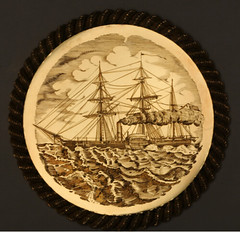
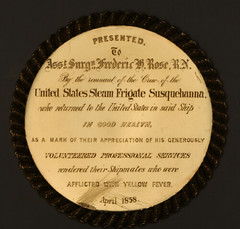
To read the earlier E-Sylum article, see: A FEW REMEMBRANCES OF CHARLES MCSORLEY (www.coinbooks.org/esylum_v14n29a08.html)
THE EARL OF PEMBROKE COLLECTION
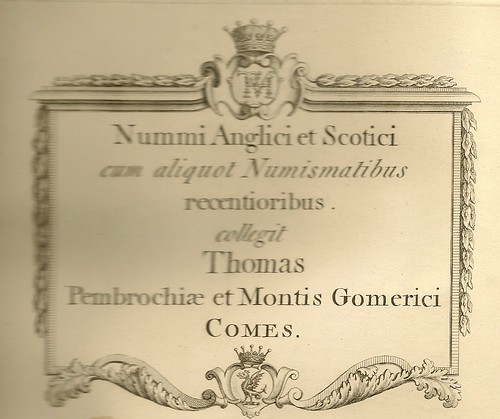
Dave Hirt writes:
I want to give some information on the book that was shown at your dinner meeting. It is the British and Scottish portion of the Pembroke collection. I have the book of the complete collection. It is a large heavy book, weighing seven pounds. It was published in 1746. The British portion is about 20% of the book. The rest is ancient coin illustrations. There is very little text.
This is how I obtained this book. I was at an ANA convention in New York in the late 1990's. I was on the bourse floor talking with Phil Carrigan. A man passed by with a large book. I asked him "What is that"? He said it is for sale. I looked at it. Phil saw the ancient coins, and said, "Dave, you wouldn't be interested in that". I said, "If what I think is in this book, IS in this book, I am interested". I found what I was looking for - the first illustrations of coins from America: Pine Tree money, Maryland money, and a Carolina Elephant token. Also illustrated is the famous (rather infamous), Good Samaritan Shilling. The spine of the book was about gone, so I had it rebound in Leather, and it now looks very nice.
David Gladfelter writes:
It is Part 4 of the engraved plates of the collection of Thomas Herbert (1656-1733), Earl of Pembroke and Montgomery, published in 1746. It's of particular interest to collectors of American colonial coins because it contains engraved images of 11 such pieces that were struck and circulated during the earl's lifetime, the earliest such images known except for John Evelyn's 1697 engraving of a St. Patrick farthing. These are on plates 11, 14, 20 and 21.
Read all about it in "The Earl's American Colonials: Ten Honest Coins and One Fantasy," The Colonial Newsletter, August 2001, page 2241. His "fantasy" is the Good Samaritan shilling, described in detail by Eric Newman in "The Secret of the Good Samaritan Shilling" (ANS, Numismatic Notes and Monographs, 1959).
PLATES OF THE ENORMOUS PEMBROKE COLLECTION OF COINS- WITH THE RARE FOURTH PART ILLUSTRATING ENGLISH, SCOTTISH AND AMERICAN COLONIAL COINS WITH THE EVEN RARER INDEX BY JOSEPH AMES.
PEMBROKE. Thomas, Earl of. Numismata Antiqua in tres partes divisa collegit olim et aeri incidi vivens curavit Thomas Pembrochiae et Montis Gomerici Comes. (London) 1746. Thick quarto, finely engraved title page, engraved title to fourth part. 306 engraved plates of coins. Contemporary full vellum, contrasting red and green morocco labels, gilt; red pages edges. An exceptional example, and one of the very best we have seen, with the entire contents, especially the engraved plates, particularly clean and crisp, and free from any browning.
The very rare fourth part, entitled "Nummi Anglici et Scotici cum aliquot Numismatibus recentioribus", is present, and apart from illustrating English and Scottish coins contained in the collection of Lord Pembroke, this final part also contains the earliest-known printed illustrations of American Colonial coins. The rare Index to the Pembrokian Coins and Medals by Joseph Ames, published some years after the main work, comprises 8 pages, including a complex and accomplished woodcut vignette on the final leaf, is also present, and is bound in at the end of the volume. The present work is the only illustrated record of a remarkable and massive collection which was dispersed at auction by Sotheby, London, over three weeks, between 31 July and 19 August 1848, and realised the then enormous sum of £5905.
THE SALE CATALOGUE OF THE PEMBROKE COLLECTION OF COINS. Catalogue of the Entire Pembroke Collection of Greek, Roman, English, Scotch, Irish and Foreign Mediaeval Coins and Medals, As Published in 1746, 4th, under the following Title:- "Numismata Antiqua, in tres partes divisa. Collegit olim et aeri incidi vivens curavit THOMAS PEMBROCHIAE ET MONTES GOMERICA COMES A.D. MDCCXLVI". Which will be sold at auction by Messrs. S. Leigh Sotheby & Co. Monday 31 July, [1848] and eleven following Days, (Sundays excepted). Octavo, pp. (ii), 326; 1500 lots; ruled in red and priced with buyers' names throughout. Contemporary half calf, red label, gilt, faded; red speckled page edges; marbled boards; slightly scuffed at extremities, inner joint broken; contents clean and fresh.
A particularly attractive example of this important and scarce sale catalogue, and with the benefit of being hand-priced and named throughout.
To read the earlier E-Sylum article, see: WAYNE'S NUMISMATIC DIARY: JULY 17, 2011 (coinbooks.org/esylum_v14n29a13.html)
SWITT'S 1933 DOUBLE EAGLES TO REMAIN IN GOVERNMENT HANDS
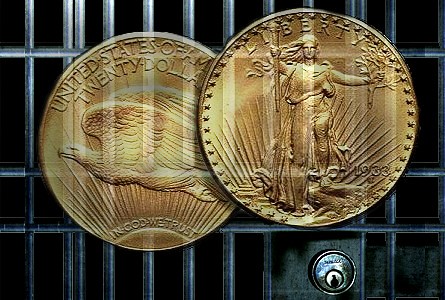
Ten rare $20 gold pieces that could have been worth millions to coin collectors will instead remain in Fort Knox and not be returned to the descendants of Philadelphia jeweler Israel Switt, a federal court jury decided Wednesday.
After five hours of deliberation following a seven-day trial, the two men and eight women declared that when the valuable Double Eagle coins ended up in the hands of the Philadelphia jeweler in the 1930s, they did not arrive legitimately.
Throughout the trial, Assistant U.S. Attorney Jacqueline Romero contended that Switt and and unknown number of his friends must have stolen the 1933 Double Eagles from the Philadelphia Mint as they were never officially released to the public. No evidence of who or how this was done was presented, only a theory that this was the only explanation of why the gold coins were in Mr Switt's possession. The coins are currently in Fort Knox, Ky.
The family contended they were legally entitled to the coins because the government could not prove they were stolen. Indeed, there was no way to know how they got out of the Mint and eventually into the Switt family's safety deposit box, said the family.
But the government contended that circumstantial evidence proved this was not the case.
The government's position was that the Mint never legally issued any 1933 Double Eagles to the public, and that all 445,500 were accounted for in mint records. But since 1937, at least 21 have surfaced, and all can be traced back to Switt. who the Government theorized got them that year from a corrupt Mint official. The Langbord-Switt attorney, Barry H. Berke argued that the coins could have been legally obtained during a "window of opportunity" in March and April 1933, when the law governing possession of gold coins was in flux.
Joan Langbord, Switts daughter, and her two sons, Roy and David, declined to comment after the verdict but appeals are expected.
However, Assistant U.S. Attorney Jacqueline Romero was more than willing to talk. "It sends a strong message" that the government will pursue crimes against the U.S. money supply, "no matter how many years pass." And on the Langbord position that the coins were legally obtained from the mint Romero said, "We did not think that was a credible story."
To read the complete article, see:
Langbord-Switt 1933 Double Eagles to Remain in Govt Hands
(www.coinweek.com/news/featured-news/langbord-switt-
1933-double-eagles-to-remain-in-govt-hands/)
ALISON FRANKEL: HOW THE GOVERNMENT WON THE SWITT 1933 DOUBLE EAGLE CASE
In a way, my favorite case of the summer was over before it started.
A couple weeks back, I wrote about the start of a Philadelphia federal court trial to determine ownership of 10 exceedingly rare 1933 Double Eagle gold coins. Granted, I have a particular affection for the case because I wrote a book about the legal furor around another 1933 Double Eagle, which ended with the coin being sold for $7.6 million at an auction in 2006. But the Philadelphia trial promised to revive the fascinating story of the 1933 Double Eagles, which were minted just as the U.S. was coming off the gold standard and were never supposed to have made their way into private hands. The daughter and sons of a Philly jeweler named Israel Switt claimed to have found 10 1933 Double Eagles in Switt's safe deposit box long after his death; the U.S. government asserted the coins had been stolen from the Mint and sued to get them back in a forfeiture action.
The trial ended this week when jurors sided with the government, finding that prosecutors Jacqueline Romero and Nancy Rue proved the coins had been stolen. Judge Legrome Davis must still rule on whether the government or Switt's family owns the coins, but that ruling is considered a formality: The 10 1933 Double Eagles will return to the U.S. government.
That result was foreordained by Judge Davis's omnibus evidentiary ruling on July 5, just before the trial started. Israel Switt's descendents, the Langbord family, wanted to keep the focus of the case on the chaos surrounding the recall of gold coins, and contradictory instructions the Mint received about handling the half-million 1933 Double Eagles that had been minted before it was deemed illegal for Americans to own gold. Their aim was to show that in those tumultuous times, coins might legitimately have slipped out of the Mint.
Government prosecutors, on the other hand, wanted to bring in evidence of Israel Switt's suspected involvement in the theft of 1933 Double Eagles from the Mint. To do so, prosecutors listed as trial exhibits a wealth of 70-year-old documents, including Secret Service reports on a 1940's investigation of how the Double Eagles got out. The agents who investigated the case concluded the coins had been stolen by a Mint employee later convicted of fencing coins. The agents also believed, according to the documents, that Switt was involved in the theft. The Secret Service asked the Justice Department to pursue a criminal case against Switt and two Mint employees, but the statute of limitations had run.
The Langbords' lawyers, led by Barry Berke of Kramer Levin Naftalis & Frankel, filed a pair of motions to limit the evidence the government was permitted to introduce here and here, raising the sort of arcane legal arguments that can only arise in a case involving events that took place decades ago and documents created by people who are long dead. The Secret Service reports, Kramer Levin argued, consisted of hearsay piled on hearsay, which made them impermissible even under the ancient documents exception to the hearsay rules. And many of the government's other documents, the Kramer briefs assert, failed to satisfy ancient documents requirements, since they weren't original documents but copies of originals that couldn't be located.
Judge Davis, however, let just about everything in: the Secret Service reports, documents from Switt's 1934 prosecution for illegal possession of gold coins (not the 1933 Double Eagles, but other coins); Mint records of questionable accuracy; a 1940s ruling in another 1933 Double Eagle case that none of the coins could have left the Mint legally. The judge said he would give the jury instructions on the context in which they were permitted to consider some of the documents, but his ruling amounted to an insurmountable obstacle for the Langbords. There was just too much government evidence casting doubt on Israel Switt's character.
To read the complete article, see:
How the government won the $75 ml Double Eagle rare coin case
(newsandinsight.thomsonreuters.com/Legal/News/2011/07_
-_July/How_the_government_won_the_$75_ml_Double_Eagle_rare_coin_case/)
MORE ON THE AMERICAN ACCOMPTANT AND THE FIRST PRINTED DOLLAR SIGN
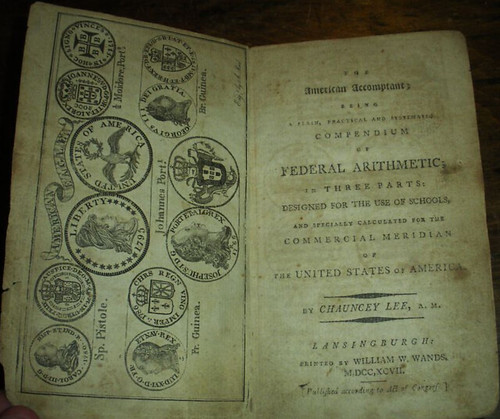
I noted with interest the commentary on Chauncey Lee's 1797 "The American Accomptant" and the claim that it includes the first printed dollar sign.
I should point out that the book is important for another reason: it includes, as a frontispiece, an engraving depicting a 1795 U.S. eagle, which Eric P. Newman has called "the earliest known illustration of a United States coin." Also included on the engraving are the Spanish pistole, French "guinea," British guinea, and Portuguese Johannes and half moidore. This illustration alone makes the book of considerable importance.
Returning to the question of whether it includes the first printed dollar sign, I have some thoughts on the matter. Lee's volume has been generally accepted for some time as including the first appearance in print of the dollar sign ($), though not without some dissent. The claim is accepted by bibliographers Charles Evans and Wright Howes, for instance. It is not accepted by Mr. Newman, who discusses the issue at length in his 1993 COAC presentation (published 1995), pages 2425.
Mr. Newman argues that: 1) Lee's symbol seems to have had no relation to the handwritten symbol then in use; 2) that his dollar symbol was original with him and "that he was not familiar with the existing conventional $ sign"; 3) that as his dime symbol more closely resembled the existing handwritten dollar sign, his printed dollar sign could not have been a modification of the handwritten version; and 4) that it therefore "seems proper to exclude" the claim that the printed dollar sign first appears in Lee's work.
It is my opinion that the dollar sign, which appears on page 56 of Lee's work for the first time and then throughout the volume, is in fact a typographical approximation of the handwritten dollar sign used by some during the period. It resembles the handwritten symbol of the day, but also differs from it. Much as a typographical ampersand is much more stylized than most of our handwritten ampersands, this initial attempt at a dollar sign in type is less a strict representation of the handwritten sign than an attempt to establish a similar sign for more formal treatment in type. It much too closely resembles the handwritten dollar sign of the day to have been created ex nihilo, and the idea that Lee was unfamiliar with the handwritten symbol seems implausible. The resemblance between Lee's dollar and dimes symbols seems to me to be more a failure in his proposed system (which did not catch on) than evidence that he was unfamiliar with a monetary symbol which had been used for some time over a considerable geographical area.
I discussed the matter with Mr. Newman, whose opinion, as I mentioned above, differs. "In view of your suggestion that I comment on the Lee publication I am glad to have the opportunity to do so," writes Mr. Newman. "I certainly agree that the book has the first printed image of a United States of America coin (this includes the FUGIO copper coinage prior to the establishment of the US Mint). I also agree that it has the first printed symbol of a United States of America coin (none existed on the Continental Currency Dollar size coin nor on prior American paper money). Those facts alone make the book very important."
Newman continues, "Where we have a possible difference of opinion, I and perhaps others think that Lee's symbol has no relationship to or development from any of the then existent written forms of the dollar $ign. Lee's thinking and book includes the preparation of a set of symbols for the dollar and each of its major fractional divisions. Each of the signals for each denomination is different but is composed of the same design elements. In other words he was not primarily creating a symbol for the dollar but for a set of distinguishing symbols for the dollar and each of its major fractional parts. He did not mention or indicate in any way that he was influenced by any prior written symbol of the dollar. He created something entirely new for the public. His symbols were almost impossible to be written by penmanship and only possible for specially prepared type for use in printing. To have a dollar symbol which in my opinion does not resemble the then written dollar sign and to have different symbols for each major fractional part of a dollar with no relationship to the then written dollar sign or any part of a dollar does not seem reasonable to me. He developed an independent arrangement of symbols based upon the existing monetary system."
"After the publication of Lee's book in 1797 there was never a use or suggested use by anyone of the printed denominational symbols developed by Lee. In fact, I know of no mention of Lee's system during the 18th or early 19th century. The accepted and presently printed Dollar $ign in type was cast in Philadelphia in 1799 and used in print that year in the anonymous pamphlet Facts Respecting the Bank of North America.'"
[Fanning again] I believe this is a matter of interpretation more than anything else, and a matter on which reasonable people can disagree. I feel that Lee's dollar sign resembles the handwritten dollar signs of the period enough to infer that his typographical symbol was an attempt to mimic the handwritten symbol while providing for a symbol complex enough to be integrated into a symbolic system capable of including all of the denominations. I also find it difficult to accept that the author of an early American accounting manual would have been ignorant of a symbol in use among merchants, etc., throughout a geographic span of the country.
Regardless of interpretations, Lee's book remains a fascinating publication, and the claim regarding its frontispiece including the first illustration of a U.S. federal coin remains to my knowledge unchallenged.
To read the earlier E-Sylum article, see: THE AMERICAN ACCOMPTANT: 1797 BOOK USING DOLLAR SIGN (coinbooks.org/esylum_v14n26a18.html)
BIBLIOMANIA, NBS, AND THE E-SYLUM
 A comment or two about things which have been and might come to be.
The first is about an item which aired on
National Public Radio's Weekend Edition, Sunday, 17 July 2011, headlined "Students Get Up Close And Personal With Rare Books."
A comment or two about things which have been and might come to be.
The first is about an item which aired on
National Public Radio's Weekend Edition, Sunday, 17 July 2011, headlined "Students Get Up Close And Personal With Rare Books."
The piece is by (Miss) Sandy Hausman, a reporter for Radio Station WVTF in Roanoke, Virginia. The audio is less than three minutes long. There is a nearly complete text in the Program Notes and a transcript which can be opened. All three of these vary slightly. The piece talks about the University of Virginia but is actually about "The Rare Book School." See www.rarebookschool.org . This school is located on the campus of the University of Virginia (but separate from it) in Charlottesville, Virginia.
Prof. Dr. Michael F. Suarez, S.J., is director of the school and is heard briefly in the report. The school lists what to me seems to be quite a large faculty. It holds a number of courses throughout the year in Charlottesville, Baltimore and Washington. Most of these courses (five to six days long) seem to be offered during the summer semester break period.
A slight pause here to regroup my forces. I am once again trying to get caught up with my reading of the latest E-Sylum issues. In doing so over the past few weeks it started to seem to me that although it is a publication for bibliophiles, there is precious little information of a more or less technical / conservation nature offered. Press releases from numismatic book sellers and publishers are interesting but not everything. Questions are sometimes raised about repairs, upkeep, lighting, binding, humidity and so on and over the next two or three weeks a few replies, beliefs, speculation and suggestions turn up but seldom is there an Expert Opinion offered.
Is there help for this (perceived?) problem just down the road? In Charlottesville perhaps? It seems there is a big herd of specialists hanging out there and maybe one or the other or even a few might just be agreeable to doing something nice and helpful for the Numismatic Bibliomania Society. And if things work out really well might do it for free. Perhaps it would be helpful if a way could be found to get in contact with the Rare Book School. Maybe somebody would be available for an Expert Opinion now and again or might be willing to write some type of bibliographic column for The E-Sylum.
Except that there are no columns in The E-Sylum -- except perhaps the two paragraphs starting each issue from The Editor. And this just might bring us to consider the speed at which things happen in The E-Sylum. Slowly -- from weekly issue to weekly issue. Digital snail mail. Dear Editor - this is not meant as criticism. Any plans in the direction of an interactive discussion site?
I think this lack of focus on the book as an object is due to the difference between a bibliophile and a NUMISMATIC bibliophile. The primary interest of the former is in books; the primary interest of the latter is in coins. As a whole NBS people are less bibliomaniacs than they are info-maniacs. We want information about our coins, medals, tokens and banknotes. That knowledge is contained in physical books, but it is also resides in people and increasingly in electronic sources such as digital web sites, web forums and electronic newsletters such as The E-Sylum.
Would we welcome regular contributions on book care and conservation? Absolutely. Consider this a plea for help, readers. If you have this expertise and are willing to share, please do consider writing for The E-Sylum and/or The Asylum. Or reaching out to The Rare Book School or some similar group to participate. Or monitor blogs in the rare book world and comment on items that would be of interest to E-Sylum readers. But it needs to be one of you - it can't be me. I don't have that expertise. I'm happy to edit and publish any relevant material that is submitted, but I don't have the time to seek it out. While listening to the NPR piece I'll admit to briefly fantasizing about how fun it would be to sign up for the Rare Book School program, but that isn't practical for me.
As for the frequency of E-Sylum publishing, that's a good question. It's funny how perceptions have changed. Back in the bad old pre-E-Sylum days, NBS communications to members were limited to the one-way quarterly publication of The Asylum. The only two-way communications took place at the annual meetings, which were attended only by a much smaller group of folks who made the trek in person to the summer ANA convention. The Internet and The E-Sylum changed that dynamic overnight - suddenly nearly every member had instant two-way access to an NBS officer and weekly publication of articles, news and commentary.
The weekly publication schedule of The E-Sylum was a deliberate decision on my part. First, I felt that an electronic publication required an editor for the same reasons a print publication does. Without some editorial control these forums can quickly devolve into chaos. And without some regular publishing schedule they can fall into disuse for time and lay dormant from simple inertia. The weekly E-Sylum schedule was a Goldilocks decision - monthly was too long, and daily was too short. Since I work during the week and could use the weekend to catch up and finalize the issue, Sunday night became the regular publishing time. It's worked out pretty well.
In short, there are no plans to change The E-Sylum's publishing schedule. Without a weekly deadline (with a whole week in between for the editor to work) The E-Sylum just wouldn't be The E-Sylum anymore - it would be something else.
But NBS does already have an interactive forum on Facebook. Comments can be posted there at any time, like Chris Fuccione did on Thursday, posting a link to an article about the 1933 double Eagle case. Only 153 people "like" the NBS page and traffic is very light, but The E-Sylum started small, too. Perhaps the forum will grow over time, either on Facebook, Google+ or whatever environment comes along next.
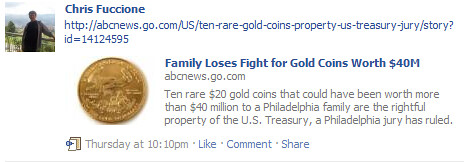
Below is an excerpt from the NPR article. -Editor
The university's Rare Book School estimates that it owns about 80,000 publications and print-related materials. And while some of those items are quite valuable, Michael Suarez director of the Rare Book School wants students to be able to handle them so they can better appreciate the history of paper, binding, typography and illustration.
"We insist that students touch and smell and shine light through items, and investigate them to understand the book in history, and understand the book as history," Suarez says.
"One of the most valuable things about this program is who you meet, and it's really nice to kind of have raw, distilled bookishness," adds Eric Johnson, a curator of books at Ohio State University.
That spirit gives Suarez and his faculty hope that books will survive even in the digital age. After all, he says, second to coins, they're the most common artifact left to us since medieval times a clear sign of their staying power.
To read the complete article, see: Students Get Up Close And Personal With Rare Books (www.npr.org/2011/07/17/137824808/students-get-up-close-and-personal-with-rare-books)
To visit the NBS Facebook page, see: www.facebook.com/pages/Numismatic-Bibliomania-Society/144733835552745
THE BOOK BAZARRE
MORE ON THE HALLMARKS OF THEOPHILUS BRADBURY
Regarding last week's item about the hallmarks of silversmith Theophilus Bradbury, Joe Boling writes:
The Theophilus Bradbury archer hallmark shown at the end of the article does not look to me like a mirror image of the stamp shown earlier in the article. I am not convinced that the four reales piece was stamped by TB.


To read the earlier E-Sylum article, see: COUNTERSTAMP RESEARCH: THE HALLMARKS OF THEOPHILUS BRADBURY (www.coinbooks.org/esylum_v14n29a14.html)
HERITAGE TO AUCTION 1792 FUSIBLE ALLOY CENT
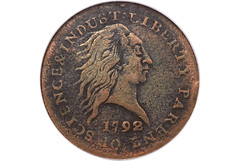 One of the great rarities of early American numismatics will cross the auction block on Aug. 11 as part of Heritage Auctions Chicago Signature® U.S. Coin & Platinum Night Auction .
One of the great rarities of early American numismatics will cross the auction block on Aug. 11 as part of Heritage Auctions Chicago Signature® U.S. Coin & Platinum Night Auction .
"Less than 10 of these great rarities are known to exist," said Greg Rohan, President of Heritage. "When one comes on the market it constitutes a real numismatic event and we expect collectors will respond accordingly when it comes time to bid."
The 1792 pattern cents, Birch cent, half disme, disme and quarter were the prototypes for what later became the cent, nickel, dime and quarter, all still staples of commerce today. These patterns were essential to the development of United States coinage.
The smaller cents from 1792 are all related, although their presentation differs. The best known of these coins is the silver center cent, proposed by Henry Voigt, who anticipated a smaller cent diameter by 64 years. Four different formats were proposed and executed for these experimental coins, as outlined by Secretary of State Thomas Jefferson in a letter to President Washington on Dec. 18, 1792:
"Th. Jefferson has the honor to send the President two cents made on Voigt's plan by putting a silver plug worth ¾ of a cent into a copper worth ¼ cent," wrote Jefferson. "Mr. Rittenhouse is about to make a few by mixing the same plug by fusion with the same quantity of copper. He will then make of copper alone of the same size, and lastly he will make the real cent as ordered by Congress, four times as big."
From the outset it is apparent that the smaller cents were experimental in nature as seen by Jefferson's reference to "the real cent" being "four times as big."
It was this necessity for preciseness of weight that doomed the fusible alloy cent and its pure copper counterpart, but which made for an incredibly valuable early American numismatic treasure. This coin possesses extraordinary historical significance, extreme rarity and commands unparalleled interest. For a determined collector, it's a once in a lifetime opportunity.
To read the complete article, see: Important 1792 Fusible Alloy Cent, One Of Less Than 10 Known, In Heritage Auctions' Chicago Event (www.ha.com/c/press-release.zx?releaseId=2051)
MORE ON DOLLAR COINS VS PAPER DOLLARS
Richard Doty writes:
It's my understanding that the staff at the Bureau of Engraving and Printing spend approximately 60% of their time printing dollar bills. Apparently they've gotten the ear of a Congressperson or two to ensure that the paper buck continues in production. (This must be the only time in recent memory when a legislator actually listened to a union guy.)
In any event, you wouldn't have to have a formal program to remove dollar bills from circulation. All you'd have to do is stop printing them and let natural attrition do its work, then demonetize the tatter'd remnants after a decent interval. That's what the British did in the early eighties and it worked fine. Unless everyone WANTS to keep currency bearing a design that was trite when introduced over eighty years ago; or Congresspersons continue to be weak in the knees before the entrenched power of the printer's union.
David Gladfelter writes:
Use of pejoratives such as "nanny state nonsense" contributes nothing to the discussion about production of coins and currency for circulation in commerce. Seems strange that the dollar bill is too insignificant in value to counterfeit, yet the £1 coin is worth faking. Our money must be as secure as possible from counterfeiting, as well as convenient to use. Both the dollar coin and the dollar bill are now accepted in most vending machines. Our government is not flush with money. If there is a substantial cost saving in the dollar coin over the dollar bill, we should switch from the bill to the coin just as other countries have done with their units of money. The one cent coin is too expensive to continue making. Even without the coin, the cent will live on in commodity pricing just as the mill (never coined) lives on in gasoline pricing.
To read the earlier E-Sylum article, see: NOTES FROM E-SYLUM READERS: JULY 17, 2011 (www.coinbooks.org/esylum_v14n29a12.html)
NOTES FROM E-SYLUM READERS: JULY 24, 2011
On Document Theft
Regarding the item about the arrest of a prominent collector and author at the Maryland Historical Society for stealing documents,
Len Augsburger writes:
I've spent a lot of time at both the Maryland Historical Society in Baltimore and the Historical Society of Pennsylvania in Philadelphia. The MdHS published my book, Treasure in the Cellar, in 2008. My current book, Secret History of the First United States Mint, was aided by source material at the HSoP - we located the fire insurance policy for the first Mint property in that collection.
The news of this theft is a punch in a gut. Archival repositories struggle with the balance of public access and good security, and anytime something like this happens everyone is a loser. As researchers we lose access and in turn the institutions fail to advance their mission of illuminating and sharing history. As researchers and collectors we must be extra vigilant in looking for the bad guys - pay attention to the researcher next to you at your local historical society - and if you see anything suspicious in the marketplace don't be afraid to speak up.
To read the earlier E-Sylum article, see: THE MAN WHO LOVED PRESIDENTIAL MEMORABILIA TOO MUCH? (www.coinbooks.org/esylum_v14n29a18.html)
More on the Snell Chinese Coin Collection
Bruce W. Smith writes:
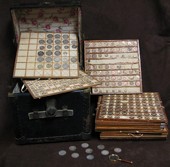 The article about the pending sale of the John Snell collection of modern Chinese coins really caught my attention. There was an earlier sale of his coins by a small coin dealer in Michigan, Fred Knust, in the 1990's I think. The collection Fred had was fairly small, and I believe, all copper coins. Also from the collection were a couple steel dies for a Chinese copper coin, probably a Hunan Republican 20 Cash. Michael Chou of Champion Gallieries Hong Kong Auctions bought the dies, and I believe they were, in the last couple years, in one of his sales.
The article about the pending sale of the John Snell collection of modern Chinese coins really caught my attention. There was an earlier sale of his coins by a small coin dealer in Michigan, Fred Knust, in the 1990's I think. The collection Fred had was fairly small, and I believe, all copper coins. Also from the collection were a couple steel dies for a Chinese copper coin, probably a Hunan Republican 20 Cash. Michael Chou of Champion Gallieries Hong Kong Auctions bought the dies, and I believe they were, in the last couple years, in one of his sales.
The information about the family is interesting. One of Snell's sons wrote a biography of his father, which I have in my library. There isn't much about numismatics as I recall. Snell, the collector, lived in China for quite a few years, and was an ANA member. He ran some ads in The Numismatist in the 1920's trying to interest Americans in modern Chinese coins. He also wrote an article on the subject which was published in The Numismatist.
To read the complete article, see: "TIME CAPSULE" SNELL COLLECTION OF CHINESE COINS OFFERED www.coinbooks.org/esylum_v14n29a16.html)
ON OPERATION BERNHARD NOTES
Joe Boling writes:
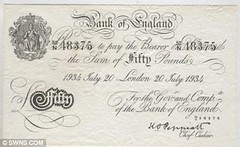 Regarding the Operation Bernhard notes being auctioned in Shropshire, first, I am surprised that these notes can be openly sold within the UK, since the genuine notes have not been demonetized. The Bank of England will still pay current notes in exchange for any white note delivered to them that passes their tests for authenticity. Second, the Bernhard notes are not at all rare (as you find stated in the full text of the article, following the link that you provided). Unless some of the others (not shown) are from branches outside London, I would be astounded if they bring even 750 pounds, let alone the 2000 that are cited as the seller's expectation.
Regarding the Operation Bernhard notes being auctioned in Shropshire, first, I am surprised that these notes can be openly sold within the UK, since the genuine notes have not been demonetized. The Bank of England will still pay current notes in exchange for any white note delivered to them that passes their tests for authenticity. Second, the Bernhard notes are not at all rare (as you find stated in the full text of the article, following the link that you provided). Unless some of the others (not shown) are from branches outside London, I would be astounded if they bring even 750 pounds, let alone the 2000 that are cited as the seller's expectation.
To read the earlier E-Sylum article, see: OPERATION BERNHARD COUNTERFEIT NOTES RECOVERED FROM LAKE TOPLITZ TO BE SOLD (www.coinbooks.org/esylum_v14n29a23.html)
OLDEST INTACT BOOK IN EUROPE
Alan Luedeking writes:
I doubt there are any coins in it, but this is interesting nonetheless! Imagine paying $18 million for one book...
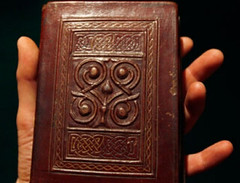 A £9m appeal has been launched by the British Library to buy the oldest intact book in Europe, a palm-sized leather-bound copy of the gospels buried 1,300 years ago in the coffin of Saint Cuthbert.
A £9m appeal has been launched by the British Library to buy the oldest intact book in Europe, a palm-sized leather-bound copy of the gospels buried 1,300 years ago in the coffin of Saint Cuthbert.
The Cuthbert Gospel, on loan to the library since 1979, is regarded as of such importance that the National Heritage Memorial Fund has raided its reserves to offer a £4.5m grant, half the purchase price and the largest single acquisition grant in the library's history. The Art Fund and the Garfield Weston foundation have each promised £250,000.
If the appeal succeeds, the library has agreed the gospel will be displayed half the time at Durham cathedral, where it was found with the body of the saint when his coffin was reopened in 1104.
The gospel is still in its original 7th century leather cover, which has survived in perfect condition.
To read the complete article, see: British Library Seeks £9m to buy oldest book in Europe (www.afanews.com/news/british-library-seeks-9m-to-buy-oldest-book-in-europe)
MAN CHARGED IN THEFT OF RARE ALASKAN NATIONAL BANK NOTES

Fairbanks locksmith Forrest R. Holton pleaded guilty Monday to stealing antique currency worth between $250,000 and $500,000 from the estate of Fairbanks banker William "Bill" Stroecker.
His plea was not part of a plea bargain, so Superior Court Judge Michael McConahy will be able sentence him to jail terms anywhere from 1 year to 3 years for the crime of first-degree felony theft. McConahy could give less or more time than this sentencing range if he finds factors that mitigated or aggravated Holton's crime.
Monday's hearing took less than 10 minutes. Holton's lawyer, Gary Stapp, requested an hour of court time at Holton's Nov. 9 sentencing to present more details about his client.
The theft occurred Dec. 29, 2010.
After Stroecker died in November 2010, the keys to his four safety deposit boxes at the downtown KeyBank could not be found.
Holton, 35, a locksmith with multinational security company Diebold, was called to drill into them.
He later made a verbal and written confession that he took a red envelope with U.S. Bank Notes, a predecessor to today's Federal Reserve Notes, that were issued by private banks.
The crime went unreported for months until several local people spotted the rare items on an online auction site and contacted the Stroecker estate.
Fairbanks police determined Holton sold 10 of the notes to an auction company on Jan. 26 for $82,000. He was in the process of selling another 30 to 40 notes with an East Coast currency dealer.
To read the complete article, see: MAN CHARGED IN THEFT OF RARE ALASKAN NATIONAL BANK NOTES (www.coinbooks.org/esylum_v14n24a18.html)
MORE ON INGLE SYSTEM SCRIP
Paul Bosco writes:
About 2 or 3 years ago I acquired some Ingle tokens, along with other US tokens including some better-than-common Civil War. I invited Steve Tanenbaum to make offers on pieces of interest, in exchange for help on things like transit tokens and coal tokens which can consume way too much time, if you don't know how to do the appropriate price-based numismatic triage.
Steve surprised me when he actually paid attention to the envelope in which I had gathered 20-30 Ingle tokens. He borrowed them and contacted someone who would attribute Ingles, in exchange for the opportunity to buy those he wanted. Naturally, I don't know the name of Steve's customer. Steve told me that the gent had sales LEDGERS from the Ingle company, with sufficient information about Ingle's customers to attribute the pieces. It seems he could attribute most or all Ingles, so he must have had most of the ledgers.
Steve said that Wagaman's catalog was prone to misattribution, as Lloyd would attach a token to the first matching name he found in a directory. If a token were issued by a Z. Q. Tarbachnikov, and you found a barkeep of that moniker in Alabama, one might reasonably assume that you had found your issuer, so that you could dispense with checking the other 49 states. But what about John Smith?
Steve paid me $20-100 for certain Ingles. Do you think I miss him??!!
John Mutch writes:
It is my understanding that Jack Siles visited the Ingle-Schierloh company headquarters in Cincinnati and transcribed the Ingle ledgers which were shipping records of (most of) the 1909 and 1914 Ingle tokens. These are the records that are being used to attribute and to correct erroneous attributions made by Lloyd Wagaman in his Ingle Tokens book (issued by IKO-TAMS). There are several copies of this transcribed information extant - I think Randy Partin's maverick CD has the info, and I know Ingle specialist John Byars has a copy. Much of the information is now on www.tokencatalog.com in the entries for specific tokens.
Richard Greever writes:
John Byars is in possession of a copy of the Ingle Customer Ledger. Jack Siles also has a copy of the same directory. Jack provided the information which was included in the Partin/Chibarro Maverick CD. John provided the information which was used on the TokenCatalog.com website. The Ingle Customer Ledger was started about 1910, so misses the early Ingle tokens. It also continues past the time of Ingle System into the time of the Insurance Credit System tokens.
John Byars has transcribed the ledger into an Excel spreadsheet, and is in the process finding Dun/Bradstreet references for all merchants to verify their attribution. Most were sent to the town of use, but some appear in the Dun/Bradstreet directories in smaller nearby towns which did not have their own Post Office. Only on very large cities was a street number included in the ledger.
I have taken the transcribed information and updated all the Ingle listings on the TokenCatalog.com website. I believe all those listings to be accurate. I have not added information to the site, when there is no associated token on the site. If a token gets added, it gets the order number put with the listing and the reverse die is identified for the die study I am currently working on.
There exists a copy of another Ingle Ledger, which is being referred to as the Ingle Order Ledger. I have not seen this ledger, but it starts about 1918 and contains order specific information. The Ingle Customer Ledger only contains the customer name, order number and shipping address.

Eric Schena writes:
I had some fantastic email and phone conversations with John Byars about the ledgers and, thanks to him, I was able to get the information I needed or pointed in the correct direction. We were able to join forces so to speak in helping fill out some of the gaps in our knowledge on some of these tokens, especially with confirming some mystery pieces I had listed. I sincerely appreciate all his time and generosity in closing some gaps I have encountered in my Virginia (and West Virginia) research & collecting, as well as talking shop about the history behind them.
Rich Hartzog (hartzog@exonumia.com) adds:
I have a few copies left of
INGLE SYSTEM SCRIP, Wagaman. 3365 listings,
70% attributed, photos. A checklist and aid to attributing the
scrip/tokens issued by the Ingle company for the many merchants. Includes
3365 listings, with 70% attributed. Some photographs, introduction.
Soft-Bound, 80p. $19.95 & $3/postage
To read the earlier E-Sylum article, see: QUERY: INGLE SYSTEM SCRIP LEDGERS AND VIRGINIA TOKEN BOOKS (www.coinbooks.org/esylum_v14n29a11.html)
CARPATHIA CAPTAIN'S CONGRESSIONAL GOLD MEDAL FOUND
Pete Smith writes:
Flanigan's medal for Captain Roston is described in The Medal in America published by the American Numismatic Society for the 1987Coinage of the Americas Conference (COAC). Donna J. Hassler wrote the article in "The Medals of John Flanagan". The Roston medal is illustrated on page 127.
The Roston medal is also mentioned in The Beaux-Arts Medal in America by Barbara Baxter. The Roston medal is #154 in the catalog and illustrated on page 45.
William H. Wilson, Jr. Commander, USCG (Ret) received a copy of the E-Sylum article from a friend and contacted me. He writes:
Here is the answer to your "query" from our President of the Titanic International Society, Inc., Charles A, Haas.
Charlie Haas writes:
An interesting question, with an answer I had almost no trouble finding. Rostron's medal is still owned by his descendants, but it is on loan to the Merseyside Maritime Museum in Liverpool, where it is presently on display. A fine photograph of that medal, and the others awarded to Rostron, can be found on pages 175-176 of Titanic and Liverpool by Alan Scarth, published in 2009 by Liverpool University Press and National Museums Liverpool (and presently available at amazon.com).
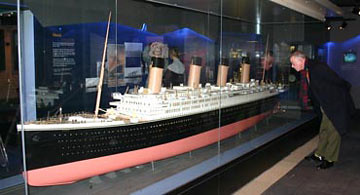
To read the earlier E-Sylum article, see:
QUERY: CARPATHIA CAPTAIN'S CONGRESSIONAL GOLD MEDAL INFORMATION SOUGHT
(www.coinbooks.org/esylum_v14n29a25.html)
THE BOOK BAZARRE
PROVIDENCE'S PARKING METER COIN CACHE
Dick Johnson writes:
News stories on parking meter rejects are not that rare. But this one has an unusual twist. Two 13-year girls as a summer project are sorting through a dozen bags accumulated from Providence, RI, parking meters over the last 50 years.
They get excited over unusual finds among the metallic flotsam in those bags, a Panama coin, an 1844 coin, and such. Could these be budding coin collectors of the future?
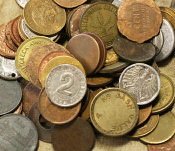 Dusty time capsules from a half-century or more ago, a dozen canvas bank bags pregnant with metallic mystery reposed in a neglected corner of City Hall's attic until archivist Paul R. Campbell grew curious and severed one old-fashioned lead-and-twine seal.
Dusty time capsules from a half-century or more ago, a dozen canvas bank bags pregnant with metallic mystery reposed in a neglected corner of City Hall's attic until archivist Paul R. Campbell grew curious and severed one old-fashioned lead-and-twine seal.
Out poured pieces of Providence's past thousands of coins, tokens, slugs and odd, inexplicable discs. Some glitter. Others are battered or bent, or dulled by time. But all are curious.
His best guess as to why public officials of the past accumulated the hoard?
"Amazing what people will put in parking meters."
So far, coins have been identified from 28 countries, and there are a variety of tokens from defunct transportation agencies.
The archivist has been assisted in his numismatic inquiry by two 13-year-olds Emma Jutras, a student at First Baptist Christian School, Warwick, and Sophia Jordan, a student at Park View Middle School, Cranston.
The girls are friends. Sophia's mother works elsewhere at City Hall. They plan to make school projects out of their summer vacation hobby.
Campbell said that when Sophia recently visited her mother at work, the girl found the bags of coins and started poring through one of them.
"When we were ready to close, she was still going through it, fascinated," he recalled.
The youngsters work with white gloves at a table. A steady clink, clink filters through the air in the quiet depository for old records. A row of plastic cups sits in front of them, bearing such labels as England, Italy, Canada, Belgium, Pakistan and India.
Campbell isn't sure if the collection is worth anything more than scrap value, but he plans to consult a coin dealer to get an estimate.
Until then, each metal memento may have a tale to tell, but time has robbed coin detectives of their witnesses, leaving only the sparse clues of dates and perhaps country of origin or the name of a vanished utility for present-day speculators to ponder.
To read the complete article, see: Parking meter cache a ticket to Providence's history (www.projo.com/news/content/CITY_HALL_COINS_07-21-11_RHP9PKK_v12.44b99.html)
On a related note Tom DeLorey adds:
I once beat a parking ticket in Sidney, Ohio because the meters in front of the Post Office offered 12 minutes for a "penny" or one hour for a "nickel." There are, of course, no such U.S. denominations. The ones down the street offered two hours for a dime, which does exist, but these meters did not.
There was no court case and no legal precedent was set, it just went away. I may have been helped by the fact that the number two man in the city Police Department was the Treasurer of the Shelby County Coin Club, of which I was Secretary at the time.
By the way, all of the parking meter money was delivered to his desk before being counted, and he got to check the dates before the coins were deposited. Over the years he found TWO dime-sized $2-1/2 gold pieces!
ROYAL NATIONAL LIFEBOAT INSTITUTION MEDALS
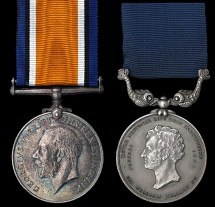 A BRAVERY medal won by a fearless lifeboatman who helped save 47 men when their ship was wrecked in a gale off the Hartlepool coast is set to help fetch up to £1,800 at an auction today.
A BRAVERY medal won by a fearless lifeboatman who helped save 47 men when their ship was wrecked in a gale off the Hartlepool coast is set to help fetch up to £1,800 at an auction today.
The silver Royal National Lifeboat Institution (RNLI) medal was presented to Herbert William Jefferson, motor mechanic for the Hartlepool lifeboat The Princess Royal, after he and his colleagues rescued 47 of the crew of the stricken steamship Hawkwood in January 1942.
Almost 70 years later Mr Jefferson's medal and his British War medal are expected to sell for between £1,400 and £1,800 at Spink, in Bloomsbury, London.
For risking their lives, each man received a gratuity of £4 eight shillings and sixpence (£4.43p in modern money).
RNLI official Brian Wead said: "An RNLI gold medal will only be awarded for a rescue in which exceptional courage, skill and initiative is shown. It is known as the lifeboatmen's VC.
"A silver medal will be awarded in circumstances that fall just short of the criteria for a gold medal and a bronze can be awarded for gallantry or merit during a rescue."
Since the RNLI was founded in 1824 and up until December 31 last year, only 119 gold medals have been awarded, while 1,558 silver medals and 799 bronze medals have been presented.
To read the complete article, see:
Lifeboat mechanic's medals could net £1,800
(http://www.peterleemail.co.uk/news/local/lifeboat_mechanic_s_
medals_could_net_1_800_1_3600108)
ROMAN ERA COIN DIE AND BLANKS UNEARTHED
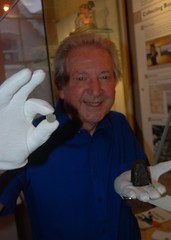 AN AMATEUR archaeologist from Aylesbury has been given a national award after uncovering a coin press which may have been used to make counterfeit currency in Roman times.
AN AMATEUR archaeologist from Aylesbury has been given a national award after uncovering a coin press which may have been used to make counterfeit currency in Roman times.
Tom Clarke, who has been metal detecting for more than 40 years, found a number of blank bronze coins and a small anvil in a farmer's field in Wing.
The unmarked discs are the halfway stage of someone making their own coins and have been dated to around 300AD.
The find, which Tom has donated to the Bucks County Museum, won him the most significant hoard' category in the Nations' Greatest Find competition, run by The Searcher magazine.
He was presented with his award in a ceremony on Monday.
"I like to think it could be someone who was making illegal coins and being a bit naughty.
"For me it's the thrill of the find. I've never made any money from my metal detecting.
Brett Thorne, one of the museum archaeologists, said: "Due to a shortage of official coins at this time many people started making their own.
"In many cases they were probably tolerated by the authorities.
"The values we are talking about are minimal.
"If they were making silver coins it would be different."
To read the complete article, see:
Award winning treasure found in Wing was used by Roman criminals
(www.bucksherald.co.uk/news/local-news/award_winning_treasure
_found_in_wing_was_used_by_roman_criminals_1_2889061)
FEATURED WEB SITE: DUKE UNIVERSITY CURRENCY COLLECTION
This week's Featured Web Site is suggested by Dan Freidus, who writes:Duke has Raphael Thian's currency collection (stored in 5 albums). They also have an archive of Thian's papers.
The Currency Collection contains 4896 pieces, 1746-1982, of which all except a small number of coins and tokens are paper currency. Most of this money is domestic, but there are a limited number of foreign items, some of them quite old and interesting. Approximately two-thirds of the collection dates from the Civil War and one-fourth from the antebellum period.

scriptorium.lib.duke.edu/pathfinders/civil-war/currency.html

